What you'll learn:
➤ Suzuki Hayabusa Buyers Guide
Are you eyeing a Hayabusa for your next ride? Buying a used one might be on your radar. I found myself in the same spot back several times.
Could Hayabusa be the ultimate ride for you?
Throughout my journey, questions about the Hayabusa kept surfacing as I delved deeper into my research.
- Can the Hayabusa serve as a daily ride?
- Is it adaptable to low-speed maneuvering, not just pushing limits close to 300 km/h?
- How effective is its wind protection?
- What about safety when riding a Hayabusa?
- Does the Gen 3 Hayabusa justify the extra cost of 50% over the older models?
I dug deep to uncover the answers. Now, I’m compiling everything I’ve learned into a comprehensive guide for purchasing a Suzuki GSX1300R Hayabusa—whether it’s pre-owned or straight off the showroom floor.
History
Let’s take a dive into the iconic Suzuki Hayabusa, also known as the GSX1300R. Delving briefly into its history, the Hayabusa claimed its place as the fastest production bike globally before a consensus limited top speeds to 299 km/h.
While other bikes might be faster now, the Hayabusa secured its victory before the regulations shifted.
In the late 1990s, the title of the fastest production motorcycle belonged to the Honda Blackbird. Suzuki, aiming for this accolade, unveiled the GSX1300R Hayabusa in 1999.
The name “Hayabusa,” Japanese for “Peregrine Falcon” (隼 in Kanji or ハヤブサ/はやぶさ in furigana), symbolizes an animal known for hunting and outpacing blackbirds.
Comparing specifications, the Honda Blackbird boasted around 120kW / 164 hp at the crank with aerodynamic prowess, achieving a top speed of 287 km/h (176 mph).
In contrast, the first-generation Suzuki Hayabusa soared to a top speed of 312 km/h (194 mph), effortlessly claiming the title of the fastest production motorcycle of its time.
In response to concerns about excessive speeds, Japanese motorcycle manufacturers collectively agreed to cap production motorcycle speeds at 299 km/h (186 mph) shortly after the Hayabusa’s triumph.
While subsequent motorcycles didn’t surpass this limit (unless modified), the Hayabusa had already established itself as the pinnacle of speed.
Despite the emergence of higher-powered bikes like the Kawasaki ZX-14R and other litre-class racing motorcycles, their potential remained unproven due to speed limitations.
Numerous high-powered bikes emerged later, including 200+hp superbikes and supercharged H2 motorcycles, hinting at untapped velocity.
👉 Discover More: Should You Save or Invest? (Teach Your Kids the Difference)
Models
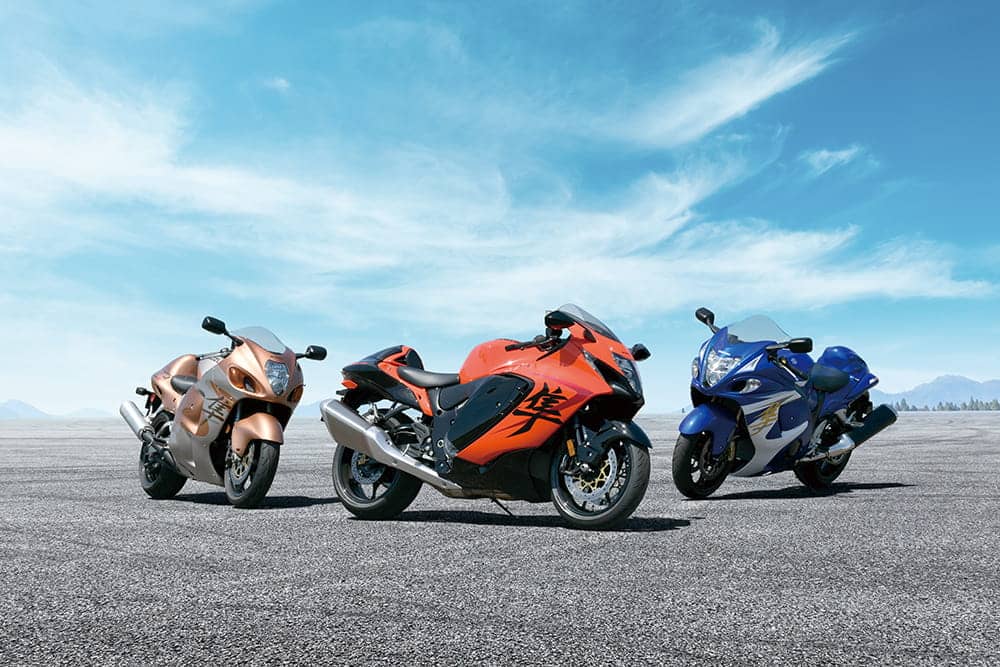
The Suzuki Hayabusa has undergone three (and a half) significant revisions in its illustrious 20+ years of production history.
While speculation about a higher-capacity ‘Busa for 2021 circulated, the final reveal presented a motorcycle with updated styling, heightened electronics, and a slight reduction in peak power due to emissions compliance.
However, the power decrease in the 2021 Suzuki Hayabusa isn’t substantial. The mid-range torque compensates well for everyday use. T
Typically, most individuals swiftly opt for an exhaust and tune on any ‘Busa, making claimed specs somewhat less crucial. Yet, a decrease in numbers, particularly on a top-speed/peak-power-focused bike like the Suzuki Hayabusa, can raise concerns.
Let’s delve into the specifics of the Hayabusa across its generations. Note that claimed power/torque specs can be altered with modifications like exhaust upgrades, tunes, or even more aggressive modifications such as long-stroke cranks or turbochargers.
Nevertheless, here are the common specs shared by all Hayabusas:
- Engine Design: Inline four-cylinder liquid-cooled 16-valve engine
- Front Suspension: KYB 43mm inverted fork, fully adjustable (with variations over generations)
- Rear Suspension: KYB monoshock, fully adjustable, link-type rear suspension
- Final Drive: 6-speed transmission, chain
- Tire Sizes: 120/70 ZR 17, 190/50 ZR 17
- Curb Weight: Approximately 260 kg / 573 lb (with variations between generations, influenced by rider weight, gear, and luggage)
Each generation of the Hayabusa has distinct differences in specifications:
- Generation 1 (1999-2007): Engine capacity of 1298cc, producing 129 kW / 175hp at 9800 rpm and 138 Nm / 102 lb-ft at 7000 rpm.
- Generation 2 (2008-2012): Engine capacity increased to 1340cc, generating 145 kW (197 PS / 194 bhp) at 9500 rpm and 155 Nm / 114 lb-ft at 7200 rpm.
- Generation 2.5 (2013-2020): Retained the 1340cc engine with similar power and torque figures as Generation 2, but upgrades included ABS, enhanced brakes, and other ride aids.
- Generation 3 (2021+): Maintains the 1340cc engine but offers 140 kW / 190 PS / 187 bhp at 9700 rpm and 150 Nm / 111 lb-ft at 7000 rpm with additional electronic enhancements, including cornering ABS/TC, cruise control, quick shifter, and steering damper.
Gen 1 (1999-2007)

The inaugural 1999 Suzuki Hayabusa marked the genesis of a legend, featuring a 1298cc liquid-cooled, inline-4, fuel-injected engine that delivered a claimed 129 kW (173 bhp) at 9800 rpm.
Surprisingly, it’s only the 1999 model that wasn’t speed restricted, holding a special place in enthusiasts’ hearts.
Subsequent editions from the first generation (2000 onwards) were limited to an indicated 299 km/h. Nevertheless, removing the speed restriction is plausible through ECU reprogramming.
The coveted “Light Copper Brown” hue of the original Gen 1 Hayabusa holds significance—an homage to the Peregrine Falcon’s coloring, embodying its namesake.
Finding an early Hayabusa in pristine condition can be challenging; many have undergone extensive modifications or high usage.
Most early models are likely to bear high miles/kilometers, potentially having experienced wheelies and boasting modifications like custom paint jobs, turbochargers, or drag racing extensions.
Unless acquiring one from a well-kept collection or through personal connections, seeking a meticulously preserved early Hayabusa might come at a collector’s price. Thus, exploring Gen 2 Hayabusas could be a pragmatic starting point.
👉 Discover More: So, Money Does Buy Happiness (Here’s How)
Gen 2 (2008-2012)

The 2008 model year marked the introduction of the Gen 2 Hayabusa, representing the first revision since its inception in 1999. These models, especially the pre-ABS versions, are notably prevalent in the second-hand market.
Key alterations to the Gen 2 Hayabusa comprised:
- Subtle body re-styling, preserving the iconic elements of the first generation
- Engine enhancements included modifications to the head and pistons, enlarging stroke to 65mm (from 63mm), elevating overall displacement to 1,340cc (from 1,299 cc), and increasing compression to 12.5:1 (from 11:1). These adjustments boosted power to 197 hp at the crank (up from 173 hp) by incorporating lighter pistons and rods.
- Valve and exhaust modifications tailored to accommodate the engine changes
- Suspension upgrades to a 43mm Kayaba inverted fork with diamond-like carbon coating (replacing the earlier TiN coating) and a Kayaba rear shock, both fully adjustable
- Enhanced windscreen for improved aerodynamics
- Interlocking gauge faces with a digital speedometer
- Transition to Tokico radial brake calipers with smaller 310 mm discs and 4-piston calipers, a departure from the 1st gen’s larger discs and 6-piston calipers
- Introduction of a steering damper
- Installation of a larger radiator and dual cooling fans
- A slight increase in dry weight to 222 kg, just 2 kg more than the earlier generation
While the second-generation Hayabusa models are relatively more accessible, motorcycles of this age category typically exhibit high kilometers. Nonetheless, enthusiast communities online often showcase well-maintained and cared-for Gen 2 Hayabusas.
Gen 2.5 (2013-2020)

In 2013, Suzuki introduced minor updates to the Gen 2 Hayabusa, marking the evolution of this model. The notable additions were:
- Standard ABS: A significant inclusion that was absent in previous iterations, providing enhanced safety features.
- Brembo M4.32 Calipers: Replacing the Tokico brakes found in the 2008-2012 versions, enhancing braking performance.
The 2013 version retained the appearance of its predecessors, with interchangeable parts apart from the brakes and fork legs.
This iteration persisted as the current model until 2020, featuring changes primarily in styling and color options. While technically still considered a Gen 2, many enthusiasts regard it as a Gen 2.5 due to the invaluable inclusion of ABS.
Speaking as an advocate for ABS, I firmly believe in its benefits. While some share anecdotes of avoiding incidents due to a lack of ABS, for most riders, ABS offers a crucial safety net. It’s designed to engage precisely when you find yourself muttering those unforgettable words.
I’ve experienced this firsthand—a momentary lapse in a slippery parking lot, swiftly averted by ABS, preventing an unintended encounter with a nearby Mazda.
For enthusiasts favoring ABS and Brembo brakes, investing in a 2013+ Suzuki Hayabusa is a wise choice. Focus on the bike’s maintenance history and your preferred color, as purchasing a new one might primarily offer a warranty you’re unlikely to need.
👉 Discover More: The Psychology of Money Summary (Top 3 Lessons)
Gen 3 (2021-)

In February 2021, Suzuki unveiled the third-generation Suzuki GSX1300R Hayabusa, the 2022 model year, signaling a significant update in its legacy.
Although greeted with enthusiasm by potential buyers like myself, the reception among certain enthusiasts was mixed due to perceived power reductions and elevated pricing.
The main updates and differences in the third-gen Hayabusa include:
- Engine: Retaining the 1340cc inline-four water-cooled engine but experiencing a slight power decrease to 140 kW compared to its predecessor’s 145 kW. This adjustment aligns with emissions regulations, with Suzuki opting not to increase displacement.
- Weight: Trimmed down by 2kg to 264 kg from the previous 266 kg.
- Fuel Consumption: A noteworthy improvement of 15% from 17.6 km/l to 14.9 km/l.
- Enhanced Safety Tech: Incorporation of a 6-axis IMU, delivering cornering ABS and lean angle-aware traction control, along with a standard bi-directional quick shifter.
- Added Technological Features: Introduction of ride modes, anti-lift control, TFT display with lean angle indication, selectable engine brake mode, launch control, speed limiter (replacing cruise control), and other advanced technologies.
- Optional Heated Grips: Surprisingly not included as standard.
- Increased Price: Reflecting additional features and advancements, the 2021+ Hayabusa tends to carry a higher price tag.
Despite its evolution in styling—a slightly more angular design while maintaining its long, muscular silhouette—many enthusiasts still perceive any change in appearance for a classic motorcycle as unfavorable.
However, close inspection reveals the new Hayabusa as a premium machine, reminiscent of my own experience with the previous model—a realization of its exceptional qualities not entirely captured in marketing photos.
While some critics view the 2021 update unfavorably—citing reduced power, alterations in aesthetics, and a significant price hike—reviews attest to its continued greatness.
The introduction of the six-axis IMU appears to boost rider confidence, enhancing the bike’s performance, especially through midrange torque, where most riders navigate.
The comparison between stock Gen 3 and Gen 2 models on a dyno illustrates a slight reduction in peak power but a noticeable improvement in midrange torque. Drag strip performances are comparable, often reliant on the rider’s skill.
However, many Hayabusa owners opt for modifications like exhaust upgrades and dyno tunes, making direct comparisons challenging.
Despite these intricacies, the new Hayabusa remains an outstanding base model, with its potential outcome contingent on the rider’s preferences or engineering expertise. The inclusion of additional safety electronics may appeal to those prioritizing enhanced safety measures.
Suzuki has also released variants such as the GP Edition in Europe and the 25th Anniversary Edition, mainly distinguished by paint schemes, decals, and occasionally extras like exhaust systems.
Here’s a glimpse of the color schemes and variants released:
- Glass Sparkle Black & Candy Burnt Gold (2022)
- Metallic Matte Sword Silver & Candy Daring Red (2022)
- Pearl Brilliant White & Metallic Matte Stellar Blue (2022)
- Metallic Matte Black No. 2 & Glass Sparkle Black (2023)
- Metallic Thunder Gray & Candy Daring Red (2023)
- Pearl Brilliant White & Pearl Vigor Blue (2023)
- GP Edition (Rosso Pista and Giallo Pista) — Europe only (2023)
- 25th Anniversary Edition (Glass Blaze Orange & Glass Sparkle Black) (2024)
25th Anniversary Model
Twenty-five years ago, the motorcycling universe witnessed a game-changer: Suzuki unleashed its revolutionary Hayabusa onto the scene.
Fast forward to today, and we’re celebrating a quarter-century of this iconic ride with the announcement of the 2024 Hayabusa 25th Anniversary Model.
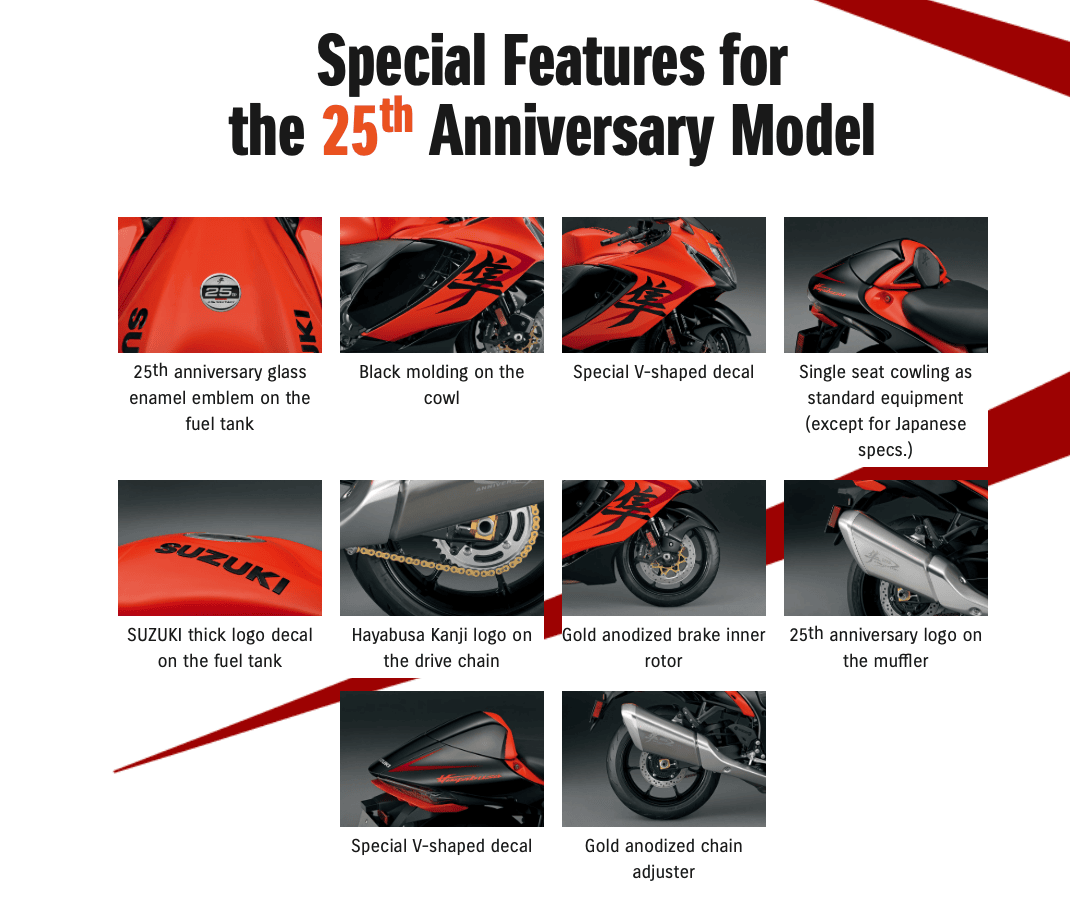
Despite the shifts and changes in the motorcycling landscape over the years, the Hayabusa has remained the undisputed champion as the Ultimate Sportbike.
This special anniversary edition maintains that legacy, boasting a powerful inline four-cylinder engine housed in a modernized chassis that blends reliability with sophistication.
It’s all complemented by an arsenal of cutting-edge electronic rider aids wrapped in stunning, unmistakably Hayabusa-esque aerodynamic bodywork.
For those who’ve dreamt of owning a Hayabusa or have had the privilege of riding one, the Glass Blaze Orange & Glass Sparkle Black commemorative edition is the new coveted prize.
The bike’s iconic silhouette has been honed through meticulous wind tunnel sessions, resulting in a body design that integrates vent shapes, air diffusers, and reimagined logos. Plus, there’s a sophisticated LED lighting system that’s as much about style as it is about function.
Under the hood, the torque-rich 1,340cc engine delivers a seamless surge of power, ensuring a smoother and quicker acceleration than ever before, all while meeting global emissions standards.
The Hayabusa rider is in absolute control, thanks to the Suzuki Intelligent Ride System (S.I.R.S.), offering adjustable power delivery, traction control, cruise control, launch control, quick shift, Motion Track ABS, and Combined Brake systems—an array of options to tailor the ride experience to their liking.
This special edition of the Gen-III Hayabusa proudly showcases anniversary emblems and logos in all the right places, with select components boasting a special gold-anodized finish. And let’s not forget the iconic solo seat cowl that comes as part of this celebratory package.
As this 25th anniversary edition hits the streets, it stands as a testament to Suzuki’s century-long commitment to crafting not just machines, but works of art—delivering unparalleled performance, quality, reliability, and value.
Just like its namesake, the peregrine falcon, the Hayabusa continues to soar high above the competition, capturing the imagination and hearts of riders worldwide.
Riding
The Suzuki Hayabusa, often termed a “hyperbike,” is renowned for its incredible speed and extreme capabilities. But the burning question for many potential buyers is: Can it handle daily riding tasks?
Surprisingly, the Hayabusa is quite versatile and adept at handling various scenarios, except for navigating dirt roads, where it might induce some apprehension.
This consideration holds significance, especially in regions like Australia, where dirt roads are fairly common.
While I’ve cautiously ventured onto dirt roads, the Hayabusa’s performance there left me somewhat wary due to its nature more suited for other terrains.
Around town and on highways, particularly cruising between 40-70 km/h or at higher speeds, the Hayabusa showcases its ease of handling.
Unlike some other high-performance bikes, which may prove uncomfortable or demanding in city traffic, the Hayabusa remains remarkably smooth and manageable.
Compared to a Ducati 1098S, notorious for its discomfort and aggressive nature in commuter settings, the Hayabusa stands out for its comfort and adaptability.
Negotiating gentle corners and roundabouts at 60 km/h is surprisingly enjoyable, given its weight. Despite being heavy, it leans effortlessly and doesn’t demand excessive effort to maneuver.
The comfort of the Hayabusa, especially for riders inclined toward a sportier posture, is noteworthy. It’s akin to wearing a high-quality glove, offering a snug fit and substantial comfort, a sentiment echoed by many riders.
The engine’s versatility is commendable, effortlessly transitioning from low to high speeds without any lag or strain. Its broad torque curve ensures a smooth ride, always providing ample power, albeit sometimes feeling like a gear change could optimize performance further.
On highways cruising between 100-120 km/h, the Hayabusa maintains a smooth rhythm, capable of higher speeds with ease but not necessarily pushing for it. However, its lack of advanced electronics like cruise control might prompt riders to exercise restraint.
For everyday riding and commuting, simple additions like gel grips and a Crampbuster significantly enhance comfort. Helibars, a modification I implemented, further contributed to a more comfortable riding experience.
👉 Discover More: An Open Letter to My Future Son & Daughter: Step 2
Speed
The Suzuki Hayabusa is synonymous with speed and power, setting a standard for throttle response that’s downright addictive.
Unlike race-tuned counterparts, the Hayabusa boasts substantial torque in lower gears, enabling effortless cruising in third or fourth without straining the engine. However, harnessing its potential at low revs requires a delicate touch.
What sets the Hayabusa apart, personally, is the absence of pressure to prove its capabilities. Unlike smaller bikes where there’s an urge to exhibit their prowess, the Hayabusa exudes confidence without needing validation.
It’s about owning the experience on your terms, unleashing power where and when you choose.
Is the Hayabusa excessively fast? Some debate whether its full potential is feasible on public roads. However, this contention applies universally, even to cars like the Toyota Corolla, which can outperform expectations in the right hands.
The Hayabusa’s power isn’t about flipping backward or overwhelming; it’s about relentless acceleration, consistently urging for more.
Despite its immense power, the Hayabusa, weighing over 250 kg and featuring an elongated wheelbase with extended gearing, remains remarkably stable. Breaking traction without deliberate actions like abrupt braking or intentional maneuvers in wet conditions is quite challenging.
Winding the throttle on a Hayabusa isn’t about hitting extreme speeds regularly. Instead, it’s the thrill of controlled acceleration, experiencing that rush while merging onto highways or open roads.
The torque curve illustrates its robust power delivery, resembling that of high-torque bikes in the lower range, escalating into a sportier surge between 6,000 and 9,000 rpm, despite not revving as high.
Comparatively, the Hayabusa’s acceleration isn’t as explosive as some v-twin superbikes, which exhibit a frenzied, rapid propulsion akin to a thousand synchronized machine guns.
Instead, the Hayabusa embodies an executive jet’s consistent, unyielding thrust forward, albeit without the manic, explosive power.
Custom exhausts, like the Micron set, elevate the experience, transforming the Hayabusa’s demeanor into something akin to a fighter plane.
What stands out is its capacity to deliver power without pushing the engine to its limit continually. Riding smaller bikes often involves wringing the throttle, whereas the Hayabusa’s ability to surge forward in higher gears with minimal effort is a distinguishing factor.
In essence, the Suzuki Hayabusa isn’t excessively fast if you revel in having ample power just a twist of the wrist away.
Electronics
In the realm of motorcycle tech, Suzuki’s 2020 iteration of the Hayabusa left many enthusiasts like myself scratching their heads. While ABS was introduced in 2013, the absence of pivotal electronic features, especially when other Suzuki models boasted them for years, was baffling.
Notably, the Gen 2.5 Hayabusa lacked traction control, relying instead on “ride modes” that restricted power delivery without actively detecting traction loss.
This deficiency was further magnified by the absence of lean-angle sensing ABS or traction control, commonly known as cornering ABS, a feature prevalent in contemporaneous bikes.
Surprisingly, the Hayabusa didn’t incorporate cruise control either, a feature now almost standard across many modern motorcycles. The absence of ride-by-wire technology meant no integrated cruise control, leaving enthusiasts to seek aftermarket solutions.
The absence of heated grips, even as an option, was another peculiar omission, particularly in the realm of sporty touring bikes. While aftermarket options exist, their absence from both the Gen 2.5 and even the Gen 3 Hayabusa (albeit as an accessory) remains notable.
Dynamic suspension, a feature increasingly prevalent in other 2020 motorcycles, was yet another missing element in the Hayabusa lineup, including the latest iteration.
While some appreciate the Hayabusa’s ‘purist’ approach, touting its absence of these electronic aids as a testament to a more authentic riding experience, I see it differently.
To me, this narrative feels more like marketing spin, serving as a justification for affection toward the Hayabusa. And there’s nothing wrong with unabashedly loving or disliking a motorcycle without the need for justifications.
However, the 2021+ Gen 3 Suzuki Hayabusa attempts to bridge this technological gap by addressing many of these omissions, even offering heated grips as an accessory. But this enhancement comes at a cost—a staggering 50% hike in price, nudging it into a premium segment.
Comparatively, looking at the ZX-14R, even in its 2017 models and onward, highlights a more comprehensive set of electronics. However, even the ZX-14R lacks some of the desired features like cruise control or cornering ABS.
In the broader context, the absence of these tech elements in the Hayabusa, while a point of contention, doesn’t tarnish its appeal for enthusiasts. Yet, it’s hard to overlook the evolving landscape of motorcycle technology that sets new benchmarks with each passing model year.
👉 Discover More: Saving for a Baby (Money Tips for New Parents)
Hayabusa vs ZX-14R
In the world of hyper-powered motorcycles, the choice between the Suzuki Hayabusa and the Kawasaki ZX-14R often boils down to personal preferences. Both machines offer over 250 kg of sheer power, crafted to devour miles at mind-bending speeds without breaking a sweat.
Specifications, in this league, don’t vary much. The ZX-14R might edge the Hayabusa slightly in sheer straight-line velocity, thanks to its higher horsepower and integrated traction control. But in essence, they both offer an exhilaratingly extreme ride.
Opting for the Suzuki Hayabusa over the Kawasaki ZX-14R might align with preferences in brand recognition. Mention the Hayabusa to someone with a passing knowledge of motorcycles, and it resonates, much like the R1 or a Ducati.
The ZX-14R, often touted as the “Hayabusa killer,” might not evoke the same recognition among the broader audience.
Moreover, the Hayabusa boasts an iconic design. Crafted primarily in wind tunnels, its aesthetics have grown to be beloved by enthusiasts, adding to its allure for many riders. The bike’s legacy and the abundance of aftermarket components for customization further cement its appeal.
For those inclined towards a simpler motorcycle with fewer tech intricacies, the Hayabusa remains an attractive choice. Its longevity in the market has made aftermarket modifications and maintenance relatively straightforward compared to more technologically advanced counterparts.
Opting for the Kawasaki ZX-14R might appeal to enthusiasts seeking sheer horsepower and performance. With peak power reaching a staggering 155 kW (208 hp) compared to the latest Hayabusa’s 146 kW (194 hp), the ZX-14R triumphs in sheer output.
Additionally, models from 2012 onwards feature traction control and versatile ride modes, elevating the bike’s technological edge over the Gen 2.5 Hayabusa.
The ZX-14R also offers a marginally different riding position, favoring some riders with a slightly more comfortable stance compared to the Hayabusa.
Its design, a subjective aspect, might sway those averse to the Hayabusa’s aesthetics while admiring the concept of a hyper-powered sportbike.
Ultimately, both the ZX-14R and the Hayabusa stand strong in their own rights. Choosing between them hinges on personal inclinations, priorities in comfort, speed, and road presence.
However, they lack some modern electronic aids like cruise control or cornering ABS, which might matter to some riders.
For many, selecting the best-condition used model among the two brands often outweighs brand loyalty. A well-maintained ZX-14R might surpass a worn-out Hayabusa, emphasizing the significance of condition over brand allegiance.
In the realm of hyperbikes, it’s less about the ‘better’ and more about the ‘best fit’ for individual preferences.
Common Issues
The Suzuki Hayabusa has earned a reputation for being an incredibly reliable platform over its years in production.
Despite its reliability, there are a few reported issues that riders have encountered, mostly concentrated in earlier models or due to usage and wear rather than inherent design flaws:
Hard Starting (Mainly in Early Models): Some early Hayabusas, particularly Gen 1 models, might experience difficulty starting. This issue could stem from several factors such as wiring, relays, or even the type of fuel used.
Interestingly, forums often suggest that the grounding wire on the starter motor could be a culprit. Ensuring proper grounding or replacing the wire might resolve this issue. Additionally, a depleted or faulty battery can contribute to starting problems.
Clutch and Gear Problems: While not an inherent issue with the design, abuse or aggressive riding habits might lead to blown clutches or gears in used Hayabusas.
Due to the bike’s capability for high performance, some riders may push it beyond its limits, resulting in mechanical stress that could cause damage to these components.
This is more prevalent in used models where the history of riding style is unknown. Ensuring a test ride and thorough inspection before purchase can help mitigate this risk.
Starter Clutch Concerns: Some users have reported issues with starter clutches, a problem that isn’t unique to the Hayabusa but is a common occurrence in various motorcycle models. It might not be as prevalent but is worth noting as a potential concern.
Overall, the Hayabusa’s reliability is well-established, and these reported issues are not widespread or endemic to the model. Routine maintenance, responsible riding, and a thorough check when purchasing a used bike can mitigate most concerns associated with the Hayabusa.
👉 Discover More: Money: Master The Game Summary (3 Valuable Lessons)
Gen 1, 2, or 3?
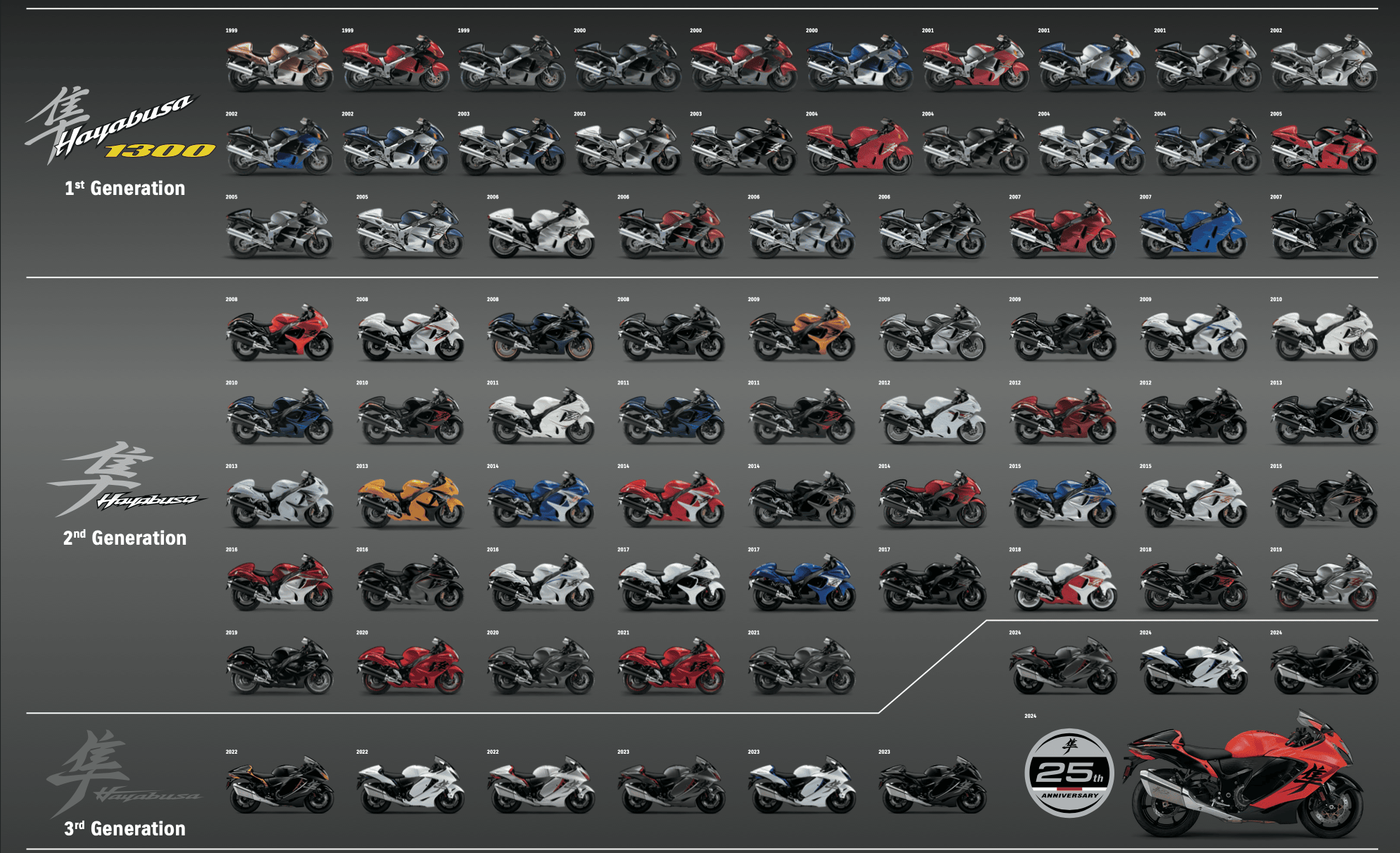
When eyeing a Suzuki Hayabusa, here are some key considerations to help you make a well-informed decision:
- Generation: If considering a Gen 1, aim for 2003 models or later due to improvements in ECU performance. However, for a more modern choice with added safety features, the Gen 2.5 (2013+) with ABS is recommended.
- Safety Features: Opting for a Hayabusa with ABS, especially from 2013 onward, enhances safety during rides. It’s a valuable feature that can be particularly reassuring in various conditions.
- Condition: Prioritize finding a well-maintained bike with a stock configuration, particularly avoiding heavily modified or aftermarket exhaust systems. A motorcycle in its original state often indicates careful ownership and maintenance.
- Mileage: Lower mileage can be a good indicator of potential wear and tear. However, a well-maintained Hayabusa with slightly higher mileage and a documented service history might still be a reliable option.
- Paint and Appearance: Ensure the paint and overall appearance are in good condition. A well-maintained exterior suggests the bike has been cared for and possibly stored properly.
- Servicing History: Look for bikes with a documented service history. Regular maintenance is crucial for longevity and performance.
When purchasing a used Hayabusa, it’s advisable to conduct a thorough inspection or have a trusted mechanic examine the bike.
Look for signs of wear and tear, especially on critical components like the engine, brakes, suspension, and frame. Additionally, test ride the bike if possible to gauge its performance and ensure your comfort with its handling.
By focusing on these aspects, you’ll increase the likelihood of finding a reliable, well-maintained Suzuki Hayabusa that meets your needs and provides a thrilling riding experience.
Comparison Images
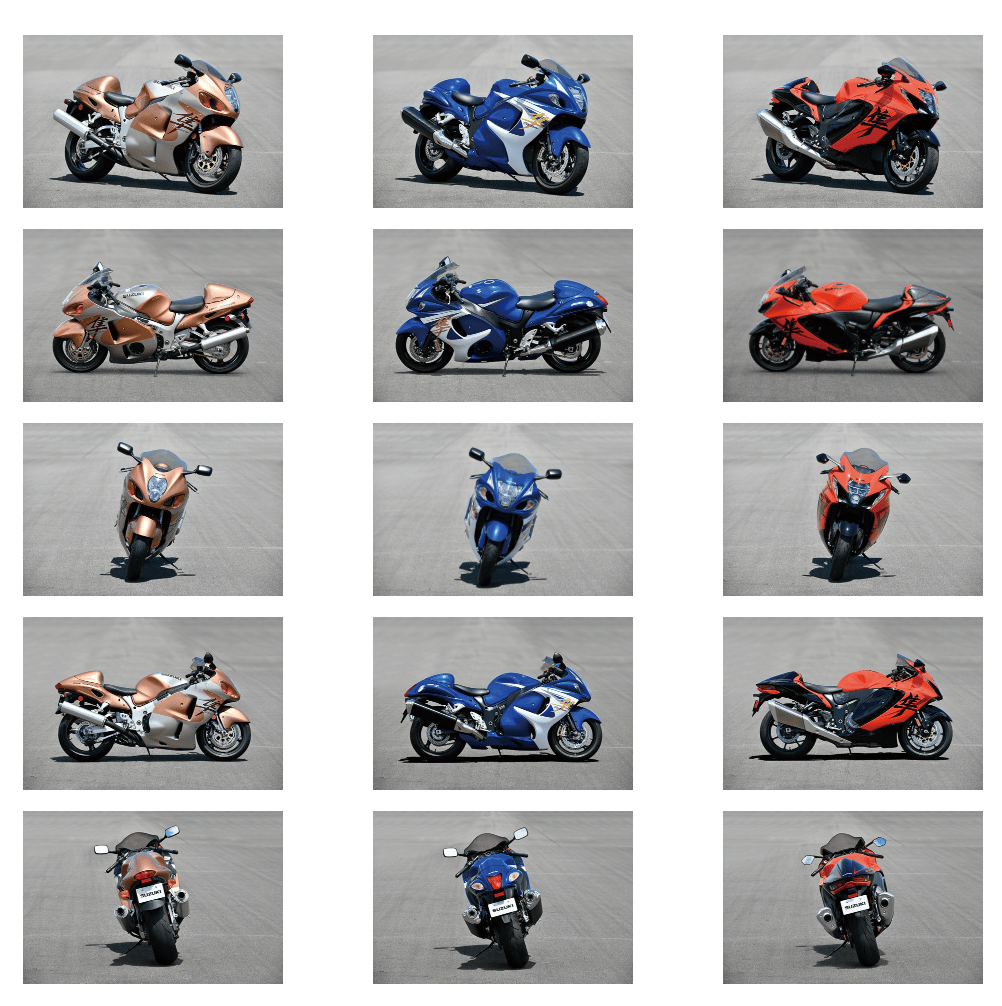
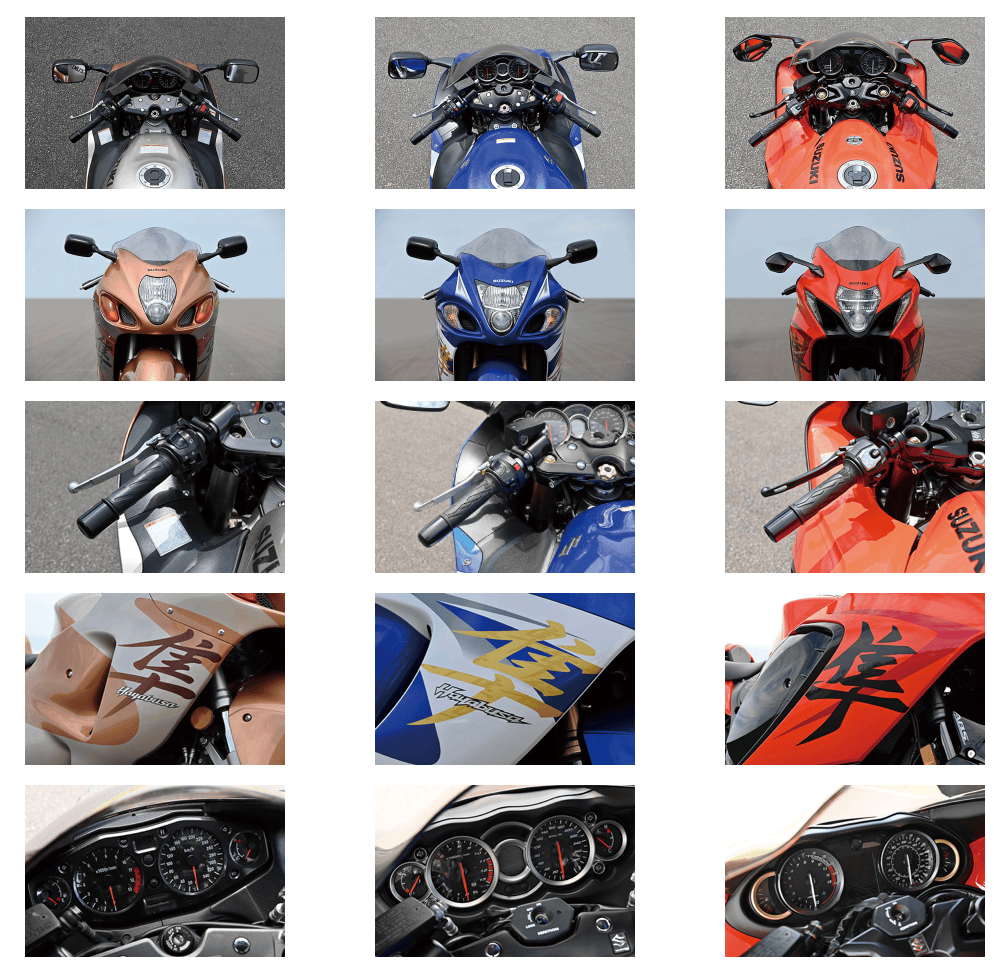
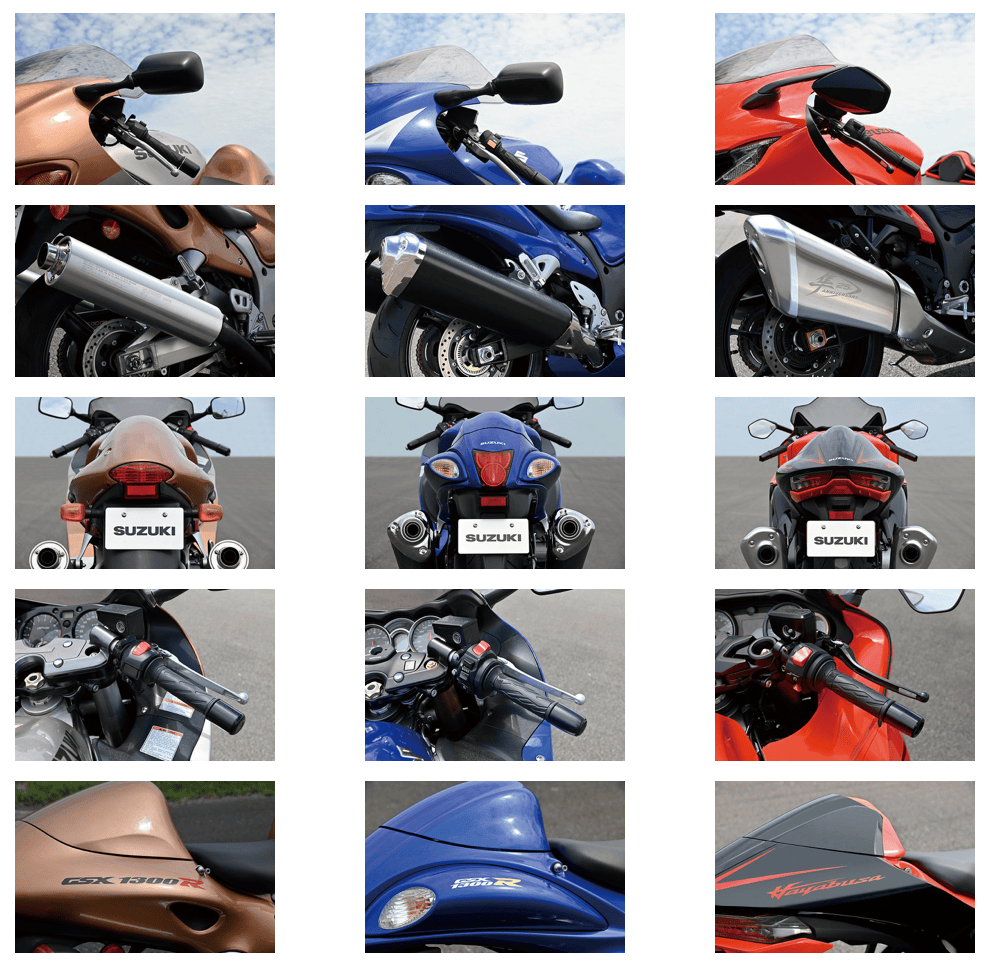
More from thoughts.money
- “The Millionaire Next Door” Summary: 9 Wealth Secrets
- “The Wolf of Wall Street” Summary: The Dark Side of Finance
- 10 Controversial Truths From “The Hour Between Dog and Wolf”
- 10 Most Expensive Stocks in History (Is the Price Important?)
- 10 Powerful Lessons From “Think and Grow Rich”
- 10 Powerful Sales Lessons From “The 3-Minute Rule”
- 10-Year Treasury Yield Climbs to 5% (Stocks Tumble)
- 100 Must-Read Books about Investing & Success
- 11 Humankind Lessons From “Sapiens”
- 11 Stress-Free Lessons From “Why Zebras Don’t Get Ulcers”
- 11 Timeless Principles for Success (Financial or Not)
- 12 Hidden Secrets From “The 48 Laws of Power”
- 12 Rules for Life Summary (Best 3 to Start Using Today)
- 12 Timeless Lessons From “The Daily Stoic”
- 14 Life Lessons From “The Snowball”
- 25 Ways to Make Money Online (And Offline)
- 3 Key Lessons from “Stocks for the Long Run” by Jeremy Siegel
- 3 Key Lessons from Think and Grow Rich
- 3 Top AI ETFs to Invest In
- 33 Best Bruce Lee Quotes (Who Was Bruce Lee?)
- 33 Jobs AI Can’t Do (And How Much Money You Can Make)
- 388 Short Inspirational Quotes to Brighten Your Day (Guaranteed)
- 4 Common Investment Mistakes Made by Millionaires
- 4 Investing Lessons From “Trade Like a Stock Market Wizard”
- 4 Long-Lost Lessons From “Outwitting the Devil”
- 4 Money Lessons From “Tax-Free Wealth”
- 4 Never-Before-Published Lessons From “Pathways to Peace of Mind”
- 5 ChatGPT Prompts to Transform Your Lifestyle
- 5 Clear Indicators You Should Decline That Job Offer
- 5 Early Retirement Tips From “Playing with FIRE”
- 5 Important Life Lessons From “Million Dollar Habits”
- 5 Investing Lessons From “Warren Buffett’s Ground Rules”
- 5 Practical Tips From “The Value of Debt in Building Wealth”
- 56% of US Employees Use AI at Work (Do You?)
- 6 Down-to-Earth Lessons From “How I Invest My Money”
- 6 Principles from “How to Win Friends & Influence People”
- 6 School Lessons From “Why A Students Work for C Students”
- 6 Simple Lessons From “The Little Book of Common Sense Investing”
- 6 Wealth Lessons From “Millionaire Success Habits”
- 7 Best Financial Goals for Students (And Why You Need ‘Em)
- 7 Controversial Investing Theories (Simplified)
- 7 Counter-Intuitive Life Lessons From “Lives of the Stoics”
- 7 Health Lessons From “The Upside of Stress”
- 7 Investing Lessons From “How to Make Money in Stocks”
- 7 Key Lessons & Takeaways from “Rich Dad Poor Dad”
- 7 Life Lessons From “Die with Zero”
- 7 Life Secrets From “The Happiness Equation”
- 7 Must-Know Truths From “What I Learned Losing a Million Dollars”
- 7 Strategies for Wealth and Happiness by Jim Rohn
- 7 Super Ideas From “One Small Step Can Change Your Life”
- 7 Unspoken Truths From Rich Dad’s “Retire Young Retire Rich”
- 7 Useful Money Nuggets from “The Richest Man in Babylon”
- 7 Ways to Teach Your Kids About Money
- 8 Companies Join Voluntary White House AI Standards
- 8 Emotional Intelligence Lessons From “The Power of Nunchi”
- 8 Health Tips From “The Stress Code”
- 8 Killer Lessons From “The Millionaire Real Estate Agent”
- 8 Life Lessons From “The Geometry of Wealth”
- 8 Money Lessons From “The Laws of Wealth”
- 8 Money Secrets From “The Richest Man in Babylon”
- 8 Practical Lessons From “The New Trading for a Living”
- 8 Proven Money Lessons From “The FALCON Method”
- 8 Psychology Lessons From “The Behavioral Investor”
- 8 Untold Secrets From “Napoleon Hill’s Golden Rules”
- 8 Upcoming IPOs to Keep an Eye On
- 9 Financial Freedom Lessons From “Rich Dad’s Cashflow Quadrant”
- 9 Lessons from Warren Buffett’s First TV Interview (1985)
- 9 Lessons to Apply Today From “The Daily Laws”
- 9 Must-Know Lessons From “The Intelligent Investor”
- 9 Smart Lessons From “Emotional Intelligence”
- A Beginner’s Guide to Investing: How to Invest in Different Asset Classes
- A Guide to the Good Life Summary (3 Top Lessons)
- A Little Indexing Never Hurt Nobody
- A Must-Know Lesson From “The First Rule of Mastery”
- Achieving Summa Cum Laude: What It Means (And How to Attain It)
- After Thanksgiving Comes Cyber Monday (What’s the Story?)
- AI Product Demand Pushes UiPath’s Revenue Up 19% (Stock Jumps 11%)
- AI Red Teams (Guardians of Digital Intelligence)
- AI Stocks to Invest In by Goldman Sacks (Besides NVDA)
- Alibaba And China Stocks Rise (Will It Last?)
- Alibaba Ex-CEO Quits Cloud Unit Ahead of IPO (Stock Slides 4%)
- Alphabet Stock Falls Despite Beating Expectations (Q3 Earnings)
- Am I the Only One Who Feels Good about This Bear Market?
- Amazon Beats Earnings Expectations (But Misses on Cloud Revenue)
- AMC Announces Stock Offering (Shares Plummet to All-Time Low)
- America’s Top 10 Richest Self-Made Women
- An Open Letter to My Future Son & Daughter: Intro
- An Open Letter to My Future Son & Daughter: Step 1
- An Open Letter to My Future Son & Daughter: Step 2
- Apple Event: iPhone 15, iPhone 15 Pro (And More)
- Apple Loses Over $200B in Market Value Amidst Earnings Turmoil
- Apple’s Stock Slides 6% Amidst China iPhone Ban
- Are $1M Homes the New Normal for Middle Class Buyers?
- Are Meme Stocks a Real Investment?
- Are We All Just Another Investing Sheep?
- Are We Losing Our Jobs to AI? (Apparently Not)
- Are You an Emotional Investor?
- Are You Doing These 6 Retirement Mistakes? (Stop Now)
- Are You Doing These 8 Investing Mistakes Too?
- Arm Goes Public (Shares Jump 25% on Day 1)
🔥 Daily Inspiration 🔥
Sometimes poverty is the greatest gift you can ever be given. Sometimes loss is the key that leads you to gain.
— Suze Orman



